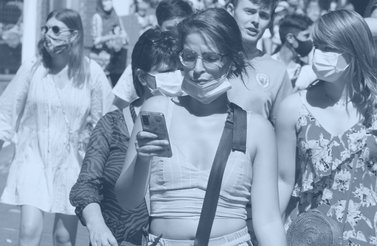e’re not just fighting an epidemic; we’re fighting an infodemic,” said World Health Organization (WHO) Director-General Tedros Adhanom Ghebreyesus at the Munich Security Conference on February 15, 2020. Responding to the overabundance of information that makes it difficult for people to identify truthful and trustworthy sources from false or misleading ones, the WHO launched a new information platform called the WHO Information Network for Epidemics (EPI-WIN) that uses a series of amplifiers to share tailored information with specific target groups.
This essay focuses on one particular aspect of the infodemic: deliberate disinformation narratives around COVID-19 and biological weapons. It analyzes key narratives that have developed and places these narratives in a broader historical context of disinformation campaigns related to public health and global health security.
Battles of influence will escalate in the future. As the lines between reality and deception become blurred, the potential for large-scale mobilization of people and resources around false narratives in a pandemic, and other crises, creates significant global risks. This essay argues that, to more effectively counter disinformation, national security and intelligence institutions must invest greater efforts to preserve and enhance societal resilience.
COVID-19 and Bioweapon Narratives
In the second half of January 2020, as the first coronavirus cases outside China were reported, rumours started circulating that linked the developing outbreak to secret labs and China’s alleged bioweapons research. Spread on social media and conspiracy theory websites, as well as through minor tabloid news outlets, the stories were based on speculation and insinuations. But one prominent article, published on January 24 in The Washington Times, a radical right newspaper not to be confused with The Washington Post, provided what seemed like a legitimate source. Dany Shoham, described in The Washington Times as a former Israeli military intelligence officer and specialist on biological warfare, but known in expert circles as contentious and unreliable, claimed a high-security government lab in the outbreak’s initial epicentre of Wuhan, China, could have been researching military applications for the coronavirus and may have been the source of the outbreak. While Shoham did not back up his claims with any evidence, The Washington Times’s story, with its appearance of authority and legitimacy, spread widely.
Battles of influence will escalate in the future.
The false narrative was quickly exposed in reputable, high-profile media outlets, most notably in The Washington Post and Foreign Policy. Yet, after a short lull, insinuations and assertions linking the outbreak to biological weapons continued. Elected officials and government representatives with larger outreach platforms became involved. US Senator Tom Cotton of Arkansas, for example, suggested in a Fox News interview on February 16 that the virus was a Chinese military creation. Manish Tewari, a prominent Indian parliamentarian and spokesperson for the Indian National Congress, the country’s leading opposition party, tweeted to his more than 380,000 followers an article from Britain’s Express tabloid that claimed the coronavirus was a bioweapon leaked from a Chinese research lab. Characterizing the outbreak as an act of terror, he urged an international investigation by the International Court of Justice or the International Criminal Court.
Another version of the bioweapons narrative also surfaced. Pushed by current and former government officials, most prominently from Iran, but also from Russia and, to some extent, China, the outbreak was portrayed as a biological attack by the US military. As the number of coronavirus cases skyrocketed in Iran, Hossein Salami, the commander of Iran’s Revolutionary Guard, said the outbreak could be “a biological attack by America which initially spread to China and then to Iran and the rest of the world.” An influential member of Iran’s parliament repeated the claim, telling an Iranian state-run news outlet that the virus had been intentionally spread throughout Iran and China. The former Iranian president, Mahmoud Ahmadinejad, sent an open letter to the UN Secretary-General, asserting it was clear that the virus was “produced in laboratories…by the warfare stock houses of biologic war belonging to world hegemonic powers.” Iran’s supreme leader issued an edict on March 12, 2020, endorsing the idea that “this incident might be a biological attack.”
In a similar effort to distract from mismanagement of the unfolding crisis at home, Chinese foreign ministry spokesperson Lijian Zhao repeated claims by a prominent Chinese epidemiologist that although the virus was first discovered in China, it may not have originated there. Zhao later told his 300,000 Twitter followers, “It might be US army who brought the epidemic to Wuhan.” Responding to the claims, the US government summoned the Chinese ambassador, and the diplomat publicly distanced himself and his government from the allegations. But Zhao’s comments fuelled conspiracy theories online, including that the contagion might have been brought in by American athletes staying in Wuhan during the Military World Games in October 2019. These posts have not been removed by China’s strict internet censors, who regularly scrub out any conversation or topic they do not want spread.
Russia’s ongoing information warfare campaign has leveraged state television, as well as social media bots and troll farms run by its intelligence services, to spread fallacies about COVID-19. The EU disinformation monitoring team, formally known as the European External Action Service’s East StratCom Task Force, collected more than 110 coronavirus-related disinformation cases from Russian sources in the January 22–March 19, 2020, timeframe. Publicly available from the EUvsDisinfo database, the disinformation cases covered a wide range of narratives, including claims the coronavirus was a biological weapon deployed by China, the United States, the United Kingdom or even Russia, and that the true origin of the coronavirus is the United States or US-owned laboratories across the world. An updated report in May by the group found pro-Kremlin sources continuing to push narratives linking COVID-19 to biological warfare, and both pro-Kremlin outlets and Chinese officials and state media falsely portraying high-security public health labs in former Soviet republics as involved in covert development of biological weapons. Analysis of Russia’s evolving tactics shows an increasing amplification of disinformation originating elsewhere, such as Iran, China or the US far right, to avoid accusations of Russia creating false content.
The Influence Operations Playbook
Using disinformation to divert attention from the mismanagement of public health crises and to stoke fears about scientific and medical issues is not a new tactic. Active measures and influence operations were a major component of anti-American strategy throughout the Cold War.
The most prominent public health campaign, in the 1980s, linked acquired immunodeficiency syndrome (AIDS) to biological weapons. Capitalizing on the uncertainty that prevailed about the origins of AIDS, and the strong public fear and uncertainty provoked by the disease, the Soviet Union fabricated and pushed a narrative asserting that AIDS was the result of American biological warfare experiments. The story was initially planted in an obscure KGB proxy newspaper in India, The Patriot, purportedly written by an American “insider” claiming that AIDS had come from US labs connected to Department of Defense or Central Intelligence Agency experiments and intended to target people in Africa. After a couple of years, the story was repeated by the Soviet journal, Literaturnaya Gazeta, and the story started spreading. It spread particularly well in the developing world, where the high cost of Western satellite feeds limited access to Western news while Soviet-bloc news services proliferated. Despite repeated rebuttals, there are many across the globe, including in America, who still believe AIDS was made in a US lab.
One of the earliest public health disinformation campaigns took place during the Korean War in 1951 and 1952, when China and North Korea alleged that the United States dropped disease-carrying insects over North Korea and northeast China to spread plague, anthrax, cholera and other diseases. A lesser-known campaign, around the same time as the Korean War, was driven by East Germany’s allegations that American planes had dropped Colorado beetles over its potato fields to induce starvation of the East German people. A German biological warfare expert commented in 2013 on a BBC World Service program: “The story was aimed at covering the government’s own inability to fight the beetles, and provided a handy extra accusation to hurl at the Americans....The East German government…had political convictions and they were concerned by the increasing danger of the developing Cold War.” Similar claims were made decades later, in the mid-1990s, by Cuba, which accused the United States of deliberately introducing insects that ravaged the Cuban potato crop. The accusations led to the only formal consultative meeting convened under the Biological Weapons Convention in its 45-year history, but the meeting was unsuccessful in getting to the bottom of the incident and the verdict was left undetermined.
During the 2002–2003 severe acute respiratory syndrome (SARS) epidemic, a Russian scientist claimed the virus was a mixture of measles and mumps that could only be made in a lab. Many Chinese seized on the notion, speculating that SARS was a genetic weapon developed by the United States to target them alone, and the official China Youth Daily linked a National Institutes of Health-sponsored genetic study in China to the US genetic warfare program. The recent Ebola outbreak in Western Africa in 2014 also suffered from smatterings of conspiracy theories and disinformation (for instance, Sputnik News, the Kremlin-controlled media outlet, accused the United States of being behind the outbreak).
More and more, education will become key, coupled with trusted sources of information: an educated citizenry capable of critical thinking is best equipped to deal with false stories and rumours.
The disinformation campaigns have drawn on what has become a tried-and-tested influence operations playbook. As others have noted, the campaigns are built around a kernel of truth, lending credibility to an otherwise entirely fabricated and unsubstantiated story. The campaigns capitalize on public anxieties about unknown diseases and take advantage of existing distrustfulness or wariness of the US government, to sow confusion, uncertainty, discord and suspicion, developing narratives that suggest Washington, and the West more generally, is, at best, incompetent and, at worst, malevolent.
At the same time, governments and supranational organizations are actively looking at ways to counter these state-sponsored misinformation campaigns. For instance, the United Nations’ “Verified” initiative is designed to increase the volume and reach of trusted, accurate information surrounding the COVID-19 crisis. Yet there remains a lot of work to be done. A recent RAND study concluded that the United States needs a revised framework to tackle foreign interference in the “infosphere.” What is clear is that before any coordinated response can be made, there must be recognition of the breadth and depth of the problem.
Societal Resilience
In the twenty-first century, it is truer than ever that competitions and conflicts arise between societies, not armies. We agree with others who emphasize that what matters is not who wins new territories, but who wins the data, the trust, the hearts and the minds of citizens. As George Orwell vividly put it in Nineteen Eighty-Four, “Power is in tearing human minds to pieces and putting them together again in new shapes of your own choosing.” Deliberately propagating false stories is nothing new, but the speed and reach of contemporary campaigns to shape and influence opinions and actions across the globe is different, and, increasingly, what was once “propaganda” is now being considered as “strategic communication.” The distinction is important: this is a coordinated tool of the state deployed to deliberately sway behaviour. Yet as the COVID-19 crisis has highlighted, it is no longer just states that are behind these efforts.
Huge efforts are under way by national governments to safeguard the physical and virtual security of their citizenry, but there remains a weakness at the heart of society: the frailty of the individual. Increasingly, preserving and enhancing societal resilience will become the most important asset for leaders. Empirical case studies of how deliberate disinformation campaigns operate, and assessments of how to successfully respond to them, including, for COVID-19, an assessment of the WHO’s EPI-WIN, will form essential supportive tools. More and more, education will become key, coupled with trusted sources of information: an educated citizenry capable of critical thinking is best equipped to deal with false stories and rumours. But education will involve more giving by the state: giving away of secrets (what are the threats and, by extension, revealing some level of knowledge about how such knowledge was obtained); of strategies in dealing with threats (and, by extension, what the current limitations in government policy are); and of contemporary information more broadly, something that is anathema to intelligence agencies. The Norwegian Intelligence Service performs this well with its annual threat assessment, but this is very much an exception to the norm. Until this happens more routinely in other countries, false stories will spread, and those willing or inclined to believe them will find ample reason to support whatever wayward whim they prefer.


